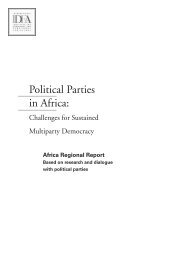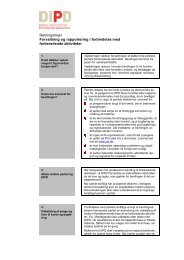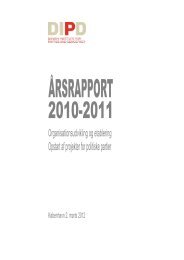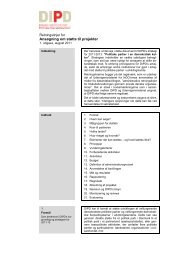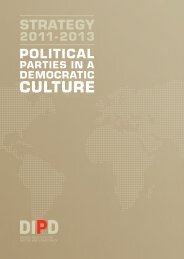Communication Strategy Guideline for Political Parties - CMD-Kenya
Communication Strategy Guideline for Political Parties - CMD-Kenya
Communication Strategy Guideline for Political Parties - CMD-Kenya
Create successful ePaper yourself
Turn your PDF publications into a flip-book with our unique Google optimized e-Paper software.
Introduction<br />
Using the <strong>Guideline</strong><br />
Various communication capacity building workshops ownership of the process and the final product. The<br />
preceded the development of this guideline. In second step is undertaking a background analysis to<br />
particular, the communication strategy building understand the context of the political party. The<br />
workshops during which each of the <strong>CMD</strong>-<strong>Kenya</strong> third step involves creating a linkage between the<br />
member political party worked through the most Party Manifesto and the objectives of the<br />
important elements of a communication strategy <strong>Communication</strong> <strong>Strategy</strong>, after which the target<br />
proved exceptionally useful. It is expected that with group is determined, the appropriate message<br />
this guideline, political parties will be able to achieve developed and channels selected to deliver the<br />
their individual communication strategies. message. The other steps are planning implementation,<br />
feedback mechanism and monitoring and<br />
The guideline provides the user with essential steps in evaluation. These are the basic elements of any<br />
preparing a communication strategy. The first step is communication strategy. The actions and activities of<br />
to determine who to involve and how to create each step are seen in table one below.<br />
TABLE 1: Steps in Preparing a <strong>Communication</strong> <strong>Strategy</strong><br />
STEP ACTION ACTIVITIES<br />
ONE<br />
TWO<br />
THREE<br />
FOUR<br />
FIVE<br />
SIX<br />
SEVEN<br />
EIGHT<br />
NINE<br />
Getting Started<br />
Background Analysis<br />
Linking the Manifesto and<br />
a <strong>Communication</strong> <strong>Strategy</strong><br />
Target Audience<br />
Message Development<br />
Vehicles<br />
Planning Implementation<br />
Feedback Mechanism<br />
Evaluation<br />
• Who to involve<br />
• How to ensure ownership<br />
• Conducting PESTEL analysis<br />
• Conducting a SWOT analysis<br />
• Identify central elements of the manifesto<br />
<strong>for</strong> a communication strategy<br />
• Branding and visibility<br />
• Identifying audiences and their characteristics<br />
• Preparing SMART messages<br />
• Matching communication methods with<br />
audiences and messages<br />
• Budgeting <strong>for</strong> implementation<br />
• Planning the timing<br />
• Organizing implementation<br />
• Assessing impact<br />
• Identifying new action to support<br />
• Collecting data<br />
• Assessing impact<br />
03 A <strong>Guideline</strong> <strong>for</strong> Preparing a <strong>Communication</strong> <strong>Strategy</strong> <strong>for</strong> <strong>Political</strong> <strong>Parties</strong> Centre <strong>for</strong> Multiparty Democracy - KENYA




